 W
WIcaricia acmon, the Acmon blue, is a North American butterfly. It ranges mainly in California but can be seen north to Oregon and south through Baja California. The tops of the wings are blue with dark edges in males and brown in females. Its underside is white with black spots for both sexes with a red-orange band on the hindwing. Adults feed on nectar while caterpillars can feed on buckwheats, lupines, trefoils, and milkvetches.
 W
WAnthocharis gruneri is a butterfly found mainly in Turkey, Transcaucasian Mountains, Asia Minor and the Armenian highlands.
 W
WArawacus aethesa is a species of butterfly in the family Lycaenidae. It is endemic to Brazil.
 W
WArgynnina hobartia, the Hobart brown, is a butterfly of the family Nymphalidae. It is endemic to Tasmania.
 W
WArhopala anthelus, the anthelus bushblue, is a species of lycaenid or blue butterfly found in the Indomalayan realm.
 W
WCatacore kolyma, the Kolyma eighty-eight, is the only species in the genus Catacore. It is a member of the brush-footed butterfly family and is found in the Neotropical realm, ranging from Colombia to Peru.
 W
WCigaritis natalensis, the Natal bar or Natal barred blue, is a butterfly of the family Lycaenidae. It is found in South Africa, from the Eastern Cape along the coast to KwaZulu-Natal, Swaziland, the Free State, Mpumalanga, Gauteng, Limpopo and North West provinces, and part of the Northern Cape province. It is also present in Botswana.
 W
WCuretis bulis, the bright sunbeam, is a species of butterfly belonging to the lycaenid family. It is found in Asia.
 W
WElymnias esaca is a butterfly in the family Nymphalidae. It was described by John Obadiah Westwood in 1851. It is found in the Indomalayan realm.
 W
WElymnias patna, the blue-striped palmfly, is a butterfly in the family Nymphalidae. It was described by John Obadiah Westwood in 1851. It is found in the Indomalayan realm.
 W
WElymnias penanga, the pointed palmfly, is a butterfly in the family Nymphalidae. It was described by John Obadiah Westwood in 1851. It is found in the Indomalayan realm.
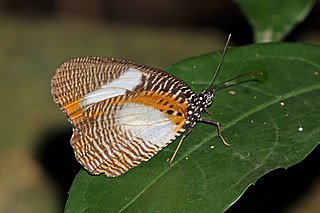 W
WElymniopsis is a monotypic butterfly genus in the family Nymphalidae. It contains only one species, Elymniopsis bammakoo, the African palmfly.
 W
WEurybia lycisca, the blue-winged euyrbia, is a butterfly of the family Riodinidae. It is found in from Mexico to Ecuador, including some Caribbean islands.
 W
WHeliophorus androcles, the green sapphire, is a small butterfly found in India and Nepal that belongs to the lycaenids or blues family.
 W
WHyphilaria parthenis is a butterfly of the family Riodinidae. It is found in low altitude areas of the Neotropical realm, from Panama to southern Brazil.
 W
WHypocysta euphemia, the rock ringlet, is a species of butterfly of the family Nymphalidae. It is found in Australia, including southern Queensland, New South Wales and Victoria.
 W
WHypolycaena antifaunus, the large fairy hairstreak, is a butterfly in the family Lycaenidae. It is found in Guinea, Sierra Leone, Liberia, Ivory Coast, Ghana, Togo, Nigeria, Cameroon, the Republic of the Congo, the Central African Republic, Angola, the Democratic Republic of the Congo, Uganda, Kenya, Tanzania and Zambia. The habitat consists of primary forests.
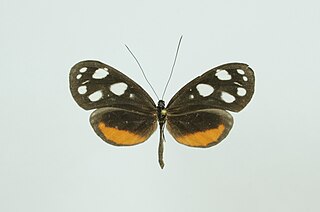 W
WHyposcada illinissa, the illinissa glasswing, is a species of butterfly of the family Nymphalidae. It is found from Colombia to Bolivia. The habitat consists of lowland rainforests at altitudes between 100 and 1,100 metres.
 W
WLibythea labdaca, the African snout butterfly, is a member of the butterfly subfamily Libytheinae found in western and central Africa.
 W
WLopinga deidamia is a species of butterfly in the family Nymphalidae. It is found from the Urals to southern Siberia, China, Mongolia, Korea and Japan.
 W
WLyropteryx apollonia, the Apollo metalmark, pink-dotted metalmark or blue-rayed metalmark, is a butterfly of the family Riodinidae, subfamily Riodininae, tribe Riodinini. The species was first described by John O. Westwood in 1851.
 W
WLysandra albicans, the Spanish chalk-hill blue, is a butterfly of the family Lycaenidae. It is found in Spain and Western North Africa.
 W
WMegalopalpus zymna, the common harvester, is a butterfly in the family Lycaenidae. It is found in Liberia, Côte d'Ivoire, Ghana, Togo, Nigeria, Cameroon, Equatorial Guinea, Gabon, the Republic of the Congo, the Central African Republic, Angola, the Democratic Republic of the Congo, southern Sudan, Uganda, north-western Tanzania and Zambia. The habitat is forest and dense agricultural land.
 W
WMelitaea parthenoides, the meadow fritillary, is a butterfly of the family Nymphalidae. Note that the common name meadow fritillary is also used for the North American species Boloria bellona.
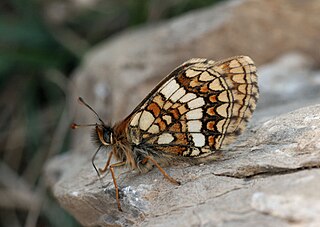 W
WMelitaea varia, the Grisons fritillary, is a butterfly of the family Nymphalidae. It is found in the Alps at heights of 1,500–2,600 m (4,900–8,500 ft), especially in the Swiss cantons Valais, Engadin and Graubünden. It is also found in the Ortler region in South Tyrol, Alpes-Maritimes and Drôme in France, high areas of Tirol in Austria and high areas in the Apennine Mountains such as Abruzzo.
 W
WNecyria bellona, the bellona metalmark, is a butterfly of the family Riodinidae. It is found in most of South America.
 W
WOgyris abrota, the dark purple azure, is a butterfly in the family Lycaenidae. It is found in Australia, from southern Queensland to south-eastern Australia.
 W
WPapilio caiguanabus, the Poey's black swallowtail, is a species of Neotropical butterfly in the family Papilionidae. It is endemic to Cuba.
 W
WParnassius tenedius, the tenedius Apollo, is an east Palearctic member of the snow Apollo genus (Parnassius) of the swallowtail family (Papilionidae). Populations range from Siberia and the Far East of Russia to the western Chukchi Peninsula, Mongolia and north China. The larva feeds on Corydalis species. In the northern part of its range it is a low altitude butterfly; further south it is montane.
 W
WPentila abraxas, the three-dot pentila, is a butterfly in the family Lycaenidae. It is found in Guinea, Sierra Leone, Liberia and western Ivory Coast. The habitat consists of forests.
 W
WPhytala is a genus of butterflies in the family Lycaenidae endemic to the Afrotropical realm. The single species of this genus, Phytala elais, the giant forest blue, is found in Sierra Leone, Liberia, Ivory Coast, Ghana, Nigeria, Cameroon, Gabon, the Republic of the Congo, the Democratic Republic of the Congo, Sudan and Uganda. The habitat consists of forests.
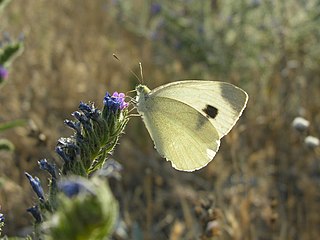 W
WPieris mannii is a butterfly in the family Pieridae.
 W
WPolyommatus actis is a butterfly of the family Lycaenidae. It was described by Gottlieb August Wilhelm Herrich-Schäffer in 1851. It is found in Asia Minor.
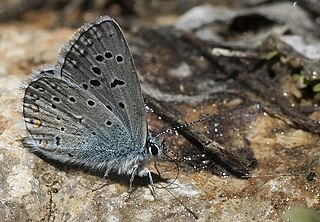 W
WPolyommatus myrrha is a species of butterfly in the family Lycaenidae. It was first described as Lycaena myrrha by Gottlieb August Wilhelm Herrich-Schäffer in 1851 in the six volume Systematische Bearbeitung der Schmetterlinge von Europa. This rare species has been found in Anatolia area of Turkey. and in the Zangezur Mountains, which is inhabited by subspecies P. m. cinyraea Nekrutenko & Effendi, 1979.
 W
WPolyommatus nivescens, the mother-of-pearl blue, is a species of butterfly in the family Lycaenidae. It is found in Spain. It is a small butterfly with a sexual dimorphism. The upperside of the male is very clear, with just a bluish beige reflection bordered by a thin grey line and a marginal line of small grey dots. The female upperside is brown, decorated with a marginal line of large orange maculae bordering the hindwings and part of the forewings. Both have a white fringe. The underside is light ochre marked with a marginal line of white lunules topped with orange, and adorned with a line of black dots circled in white very marked on the fore.
 W
WPseudochazara mniszechii, the tawny rockbrown, is a species of butterfly in the family Nymphalidae. It is confined to Greece, Turkey, northern Iran, Balochistan, and the Caucasus.
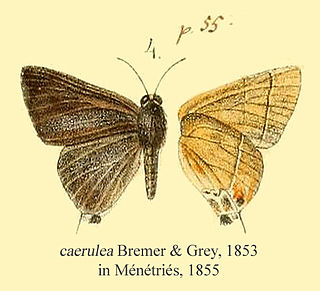 W
WRapala caerulea, the bush clover, is a butterfly of the family Lycaenidae. It was described by Otto Vasilievich Bremer and William Grey in 1851. It is found in north-eastern and central China, Taiwan, Korea and the Russian Far East.
 W
WSpalgis epius, the apefly, is a small butterfly found in the Indomalayan realm that belongs to the lycaenids or blues family. It gets its name from the supposed resemblance of its pupa to the face of an ape.
 W
WStichophthalma howqua is a species of butterfly in genus Stichophthalma. It was described by John O. Westwood in 1851, and its subspecies can be found in Southeast Asia and China.
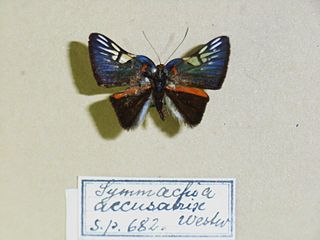 W
WSymmachia accusatrix is a butterfly species present in Mexico, Ecuador, Colombia, Brazil and French Guiana.
 W
WTaenaris phorcas is a butterfly of the subfamily Morphinae in the family Nymphalidae.
 W
WTaenaris selene is a butterfly in the family Nymphalidae. It was described by John Obadiah Westwood in 1851. It is found in the Australasian realm.
 W
WTelipna acraea, the common telipna, is a butterfly in the family Lycaenidae. It is found in Sierra Leone, Liberia, Ivory Coast, Ghana, Togo, Nigeria, Cameroon, the Central African Republic and the Democratic Republic of the Congo. The habitat consists of forests.
 W
WThaumantis noureddin, the dark jungle glory, is a butterfly in the family Nymphalidae. It was described by John Obadiah Westwood in 1851. It is found in the Indomalayan realm.
 W
WThermozephyrus ataxus, the wonderful hairstreak, is a small butterfly found in India that belongs to the lycaenids or blues family.
 W
WZeuxidia doubledayi , the Scarce Saturn, is a large butterfly that belongs to the Morphinae group of the family Nymphalidae. It was described by John Obadiah Westwood in 1851. It is found in the Indomalayan realm.